Hummingbirds in Georgia
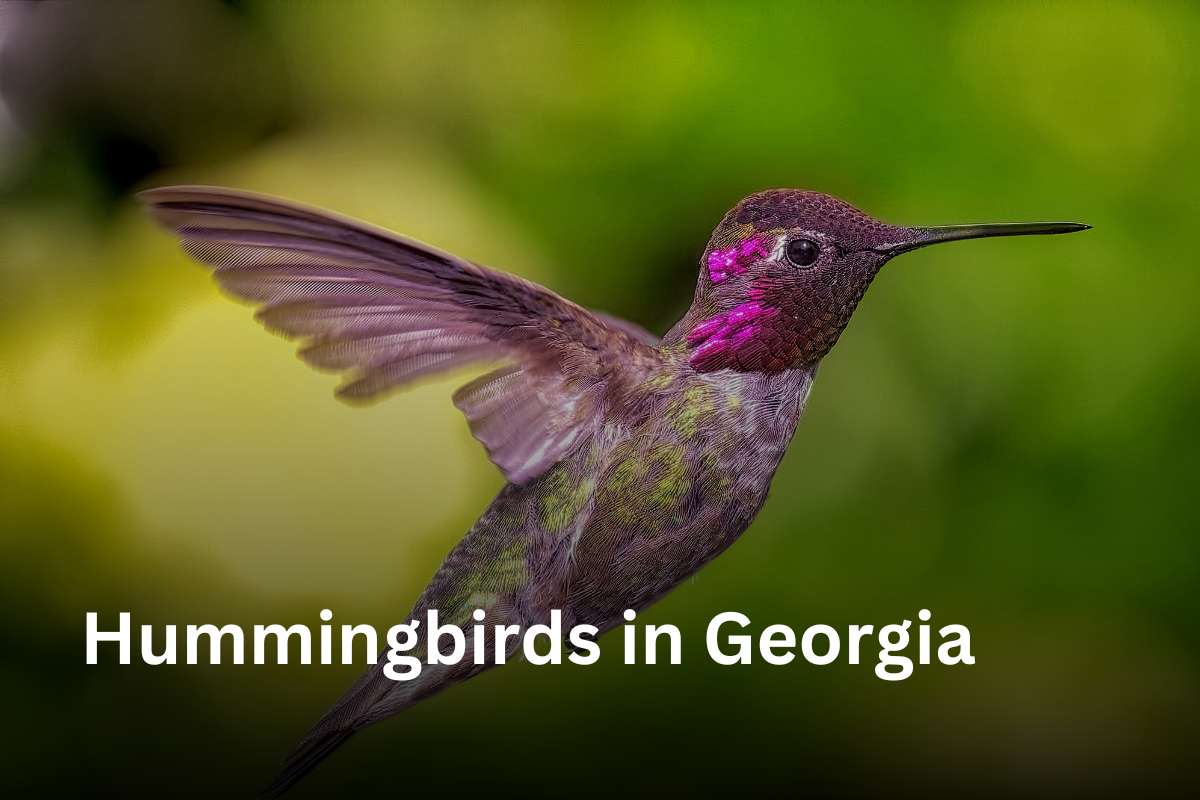
Hummingbirds are one of the most captivating and colorful visitors to our backyards. Georgia is a state located in the southeastern region of the United States.
In the United States of Georgia, various species of hummingbirds are found and the presence of these birds in yards, gardens, and parks adds a touch of vibrant elegance to its diverse ecosystem.
As stated by the Records Committee of the Georgia Ornithological Society (GOSRC), there are around 424 species found in Georgia state. These fascinating creatures reflect their unique physical appearance, habitats, behaviors, and feeding.
In the following blog post, we will be exploring the 12 most common and well-known species of hummingbirds in Georgia state. Stick with us til the end.
List Of 12 Hummingbirds in Georgia
- Rivoli’s Hummingbird (Eugenes fulgens)
- Allen’s Hummingbird (Selasphorus sasin)
- Ruby-throated Hummingbird (Archilochus colubris)
- Green-breasted Mango (Anthracothorax prevostii)
- Rufous Hummingbird (Selasphorus rufus)
- Blue-throated Mountain-gem (Lampornis clemenciae)
- Calliope Hummingbird (Selasphorus calliope)
- Black-chinned Hummingbird (Archilochus alexandri)
- Buff-bellied Hummingbird (Amazilia yucatanensis)
- Broad-billed Hummingbird (Cynanthus latirostris)
- Broad-tailed Hummingbird (Selasphorus platycercus)
- Anna’s Hummingbird (Calypte anna)
1. Rivoli’s Hummingbird (Eugenes fulgens)
The Rivoli’s hummingbird is a large species of hummingbird that belongs to the family Trochilinae. This lovely hummingbird is also known as the magnificent hummingbird.
The Rivoli’s hummingbird is regarded as one of the two largest hummingbirds found in the United States. In adult males, its upper body is dark green-bronze with a violet crown and a black-tipped tail.
The male also has a white spot behind the eye. Regarding their bill, this species of hummingbird has clinal variations in its long, straight, and slightly decurved bill.
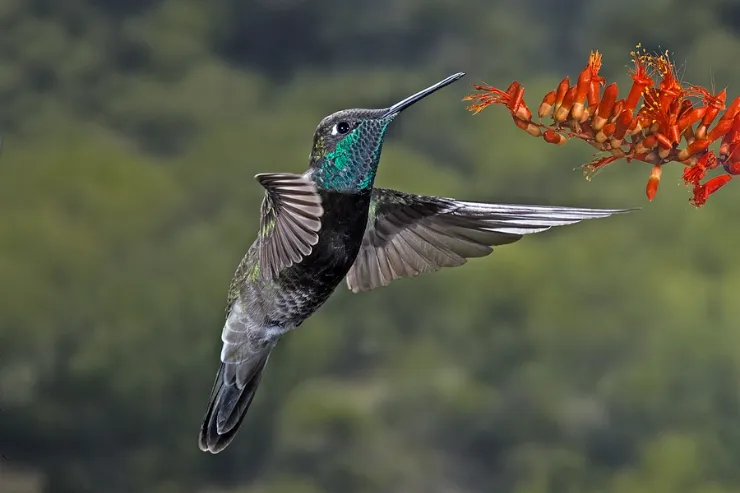
In like manner, the adult female has bronze-green on the above with a dull gray ventral coloring. The underparts of the female are grayish-white while the immatures are darker and brown.
Rivoli’s Hummingbird Size, Weight, Wingspan, Lifespan, and Breeding Period:
- Size: 11 to 14 cm (4.3 to 5.5 inches)
- Weight: 6 to 10 g (0.21 to 0.35 ounces)
- Wingspan: 18 cm (7.1 inches)
- Lifespan: 11.2 years
- Breeding Period: May to July
The Rivoli’s hummingbird is assessed to be listed as least concern according to the International Union for Conservation of Nature (IUCN).
As of now, the exact population size of these birds is not known, but, we can assume that there is a stable population. The oldest male Rivoli hummingbird was recorded to live for at least 11 years and two months.
Habitat: This hummingbird is especially found in the open grasslands, secondary forests, tree line areas, edges, and cloud forests.
Commonly, it is found in the southwestern United States, Guatemala, Mexico, Nicaragua, and El Salvador.
Feeding: Primarily, the Rivoli’s hummingbird feeds on small insects and nectar from a wide variety of flowering plants. At the time of hovering, it captures the small insects by gleaning in the mid-air.
2. Allen’s hummingbird (Selasphorus sasin)
The small-sized Allen’s hummingbird is closely related to the Rufous hummingbird. The compact and stocky hummingbird is recognized as one of the seven species of the genus Selasphorus.
The adult male has a green head and a reddish-orange throat. Their backs are greenish with rufous flanks, tails, and orange bellies.
Likewise, the females as well as immature hummingbirds are mostly metallic green and have white tips. However, the female hummingbird lacks the iridescent throat patch.
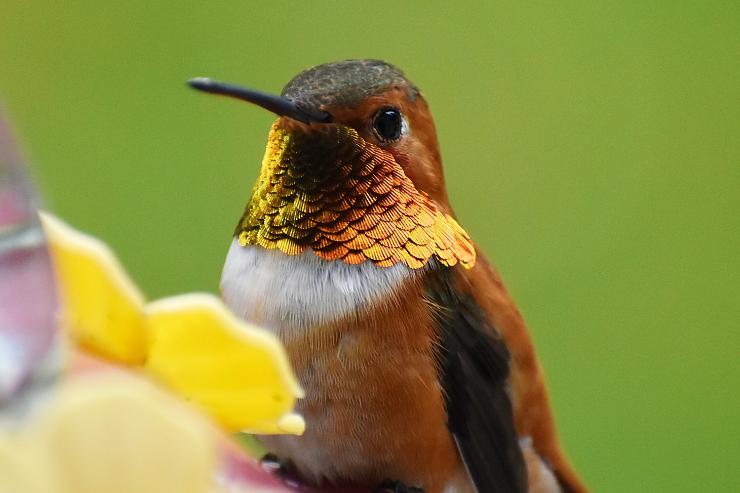
Allen’s Hummingbird Size, Weight, Wingspan, Lifespan, and Breeding Period:
- Size: 3.5 inches (9 cm)
- Weight: 2 to 4 grams (0.1 ounces)
- Wingspan: 4.3 inches (11 cm)
- Lifespan: two to five years
- Breeding Period: Early January
As per the IUCN status, the conversation status of Allen’s hummingbird is classified as least concern. The average lifespan of Allen’s hummingbird is two to five years.
Habitat: Commonly, they breed in gardens, meadows, brushy woods, coastal forests, and chaparral. It ranges from coastal California to southern coastal Oregon.
Feeding: The Allen’s hummingbird diet mostly depends on the nectar from flowers and small insects.
3. Ruby-throated Hummingbird (Archilochus colubris)
The ruby-throated hummingbird is a species of hummingbird that belongs to the family Trochilidae. It is a tiny hummingbird that has metallic green in the upper parts of the adult male.
It also has grayish-white underparts that contrast with a bright red throat, green crown, and long black wings. Likewise, the female ruby-throated hummingbird is golden-green in the upper parts and whitish in the lower parts, white throat with dusky streaks or stipples.

Regarding the size, the females are slightly larger than males. These vibrant birds have short legs with no knees. Its bill is long, slender, and straight. These hummingbirds are sexually dimorphic.
Ruby-throated Hummingbird Size, Weight, Wingspan, Lifespan, Bill, and Breeding Period:
- Size: 2.8 to 3.5 inches (7 to 9 cm)
- Weight of male: 0.4 g (0.12 ounces)
- Weight of female: 3.8 g (0.13 ounces)
- Wingspan: 3.1 to 4.3 inches (8 to 11 cm)
- Lifespan: three to five years
- Bill: 0.79 inches (2 cm)
- Breeding Period: Between March and July to mid-May
In the early 21st century, the population of the ruby-throated hummingbird decreased rapidly over the years by 17%.
The latest data available by the IUCN Red List states that this hummingbird is assessed as of least concern for risk of extinction. However, it is significantly reducing the species of this hummingbird.
The expected life expectancy of the ruby-throated hummingbird is three to five years. One of the oldest female ruby-throated hummingbirds was found to be at least nine years and two months old.
Habitat: This tiny bird can be easily observed in gardens, woodlands, forest edges, orchards, deciduous forests, and pine forests. It is recognized as one of the largest breeding range hummingbirds in the United States.
Commonly, they are found in Mexico, Central America, Florida, Canada, and Eastern North America. One of the species of hummingbird is a ruby-throated hummingbird that nests in Georgia.
Feeding: These birds use their long extendable tongue to eat nectar from flowers and flowering trees.
Along with that, the ruby-throated hummingbird also feeds on small insects and spiders which are the main part of their food.
The most important source part of protein, minerals, and vitamins comes from the small arthropods. While the younger hummingbirds lack enough protein from the nectar. So, they fed on insects.
4. Green-breasted Mango (Anthracothorax prevostii)
Formerly, the green-breasted mango was also known as the Prevost’s mango. This species of hummingbird is large. Both male and female hummingbird has a dull black bill which is slightly decurved.
The adult male has a solid metallic bronze-green on the crown, upperparts, and nape. Their tail feathers are dull dusky bronze, green to dull coppery bronze.
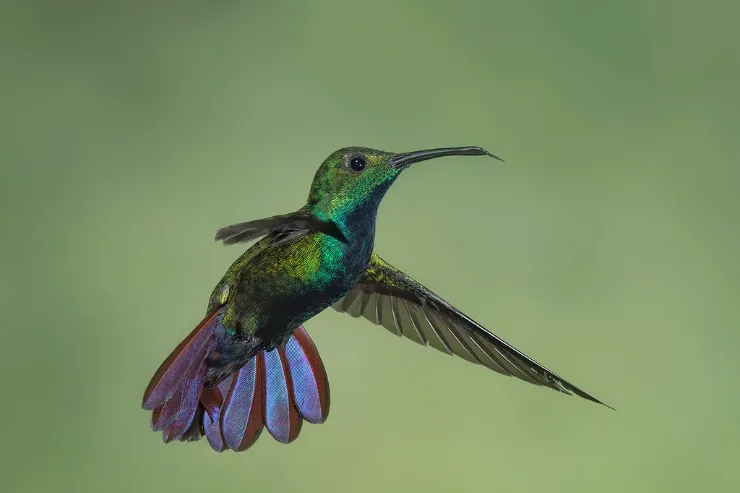
Females have less bronzy metallic green on the crown, nape, and upper parts than males.
While the immature and female, green-breasted mango has a white chin, throat, and a broad dark stripe down the center of the breast.
Green-breasted Mango Size, Weight, Lifespan, and Breeding Period:
- Size: 0.3 to 12.1 cm (4.1 to 4.8 in)
- Weight: 5.7 to 7.0 g (0.20 to 0.25 ounces)
- Lifespan: three to four years (10 to 15 years in the wild)
- Breeding Period: Between March and June
The expected lifespan of the green-breasted mango is nearly three to four years. According to the International Union for Conservation of Nature’s (IUCN) Red List, the green-breasted mango is assessed as least concern.
Habitat: The green-breasted mango is a partial migratory hummingbird. They are found in the lowland tropics of various landscapes, open, and semi-open areas. Such as savanna, gallery forest, mangroves, and dense edge of forests.
Generally, this species is often found in eastern Mexico south, Central America, Colombia, and Venezuela. But it is vagrant in some parts of the United States.
Feeding: The large-sized hummingbird forages for nectar from a wide variety of flowering trees, bromeliads, herbaceous plants, and shrubs. This species of hummingbird takes nectar at the time of hovering. It also consumes insects and spiders by hawking from a perch.
5. Rufous Hummingbird (Selasphorus rufus)
The rufous hummingbird is a small species of bird that is especially known for its extraordinary flight skills. In males, they have a rufous face, white breast, flanks, an iridescent orange-red throat patch or gorget.
The female and immature hummingbirds have green color in the upperparts with a rusted-washed flank. It also has green, white, and some iridescent orange spots on the throat.
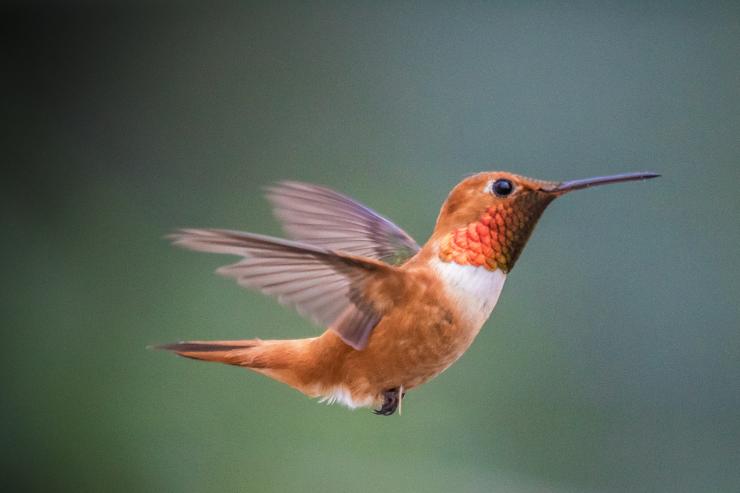
Female hummingbirds and rare green-backed male hummingbirds are quite hard to differentiate their unique appearance from Allen’s hummingbird.
Rufous Hummingbird Size, Weight, Wingspan, Lifespan, and Breeding Period:
- Size: 7 to 9 cm (2.8–3.5 inches)
- Weight: 2 to 5 g (0.071–0.176 ounces)
- Wingspan: 4.3 inches (11 cm)
- Lifespan: three to five years
- Breeding Period: April to July
As per the IUCN Red List, the rufous hummingbird is listed as least concern to near threatened in 2018.
The average lifespan of this tiny species of hummingbird is three to five years. Also, the oldest rufous hummingbird was recorded to have lived for at least eight years and eleven months.
Habitat: The rufous hummingbird breeding habitat ranges in the mountainsides, forest edges, and open areas. They are often observed in southern Alaska through British Columbia, the Pacific Northwest to California.
This bird migrates to nearby lowlands in the Rocky Mountains from May to September. During the winter season, the rufous hummingbird can travel over 3200 km or 2000 miles from their nearest summer home.
Feeding: These beautiful birds feed on nectar from flowers with the help of a long extendable tongue. This hummingbird is mostly active during the day. During the night, it becomes torpid to save its energy.
Being small-sized hummingbirds, they are known for being vulnerable to eating insects, birds, and animals.
6. Blue-throated Mountain-gem (Lampornis clemenciae)
This beautiful bird is also known as the blue-throated mountaingem or blue-throated hummingbird.
It is a large species of hummingbird that belongs to the family of Trochilidae. The male hummingbird has black eyes with a white stripe below and behind the eye.
It also has a blue gorget with a narrow buffy gray margin. Along with that, males also have white spots on their tails which are visible only at the time of flight.
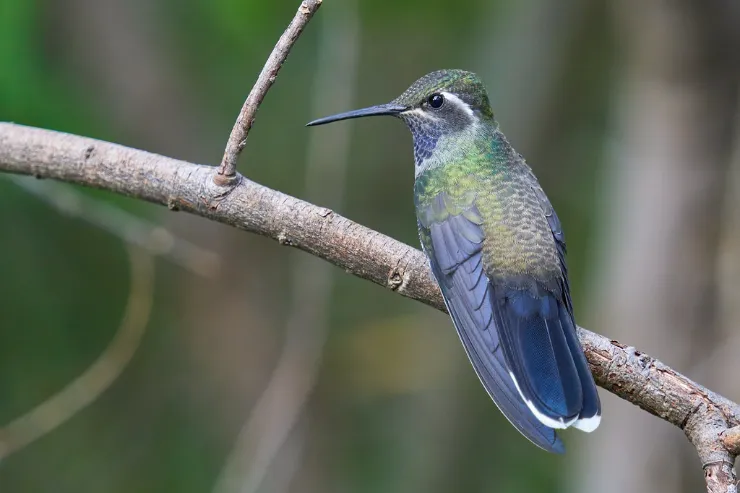
The female blue-throated mountaingem has longer black bills than that of males. While its entire underparts are medium gray with an absence of gorget.
Blue-throated Mountain-gem Size, Weight, Lifespan, and Breeding Period:
- Size: 4.4 to 5.0 inches (11.2 to 12.8 cm)
- Weight of male: 0.30 ounces (8.4 g)
- Weight of female: 0.24 ounces (6.8 g)
- Lifespan: eight years
- Breeding Period: mid-April to May
The blue-throated mountain gem’s life expectancy is nearly eight years. Although the oldest Blue-throated Mountain-gem was a male that was recorded to live at least seven years and eleven months.
In Arizona, this hummingbird was recaptured and rereleased during banding operations. According to the IUCN Red List, the blue-throated mountaingem is classified as the species of the least concern.
Habitat: Being the largest species of hummingbird, it is widely distributed in the United States. They can be found in riparian forests, mixed coniferous forests, and pine-oak forests in the mountains.
Feeding: Commonly, the blue-throated mountaingem hovers to feed on nectar. It forages the nectar from a variety of flowering plants. During the breeding season, it feeds on
7. Calliope Hummingbird (Selasphorus calliope)
The calliope hummingbird is the smallest breeding bird that was named after the Greek muse Calliope. It belongs to the family of Trochilidae and is only a member of the genus Stellula.
This little tiny bird is the smallest hummingbird and is well-known as a long-distance bird migrant. Throughout the year, it migrates twice for about 9000 km or 5600 miles.
Earlier, the calliope hummingbird used to belong to its genus name as the little star. This adult male has a wine-red magenta ray on the throat, glossy green flanks, and a dark tail with white underparts.
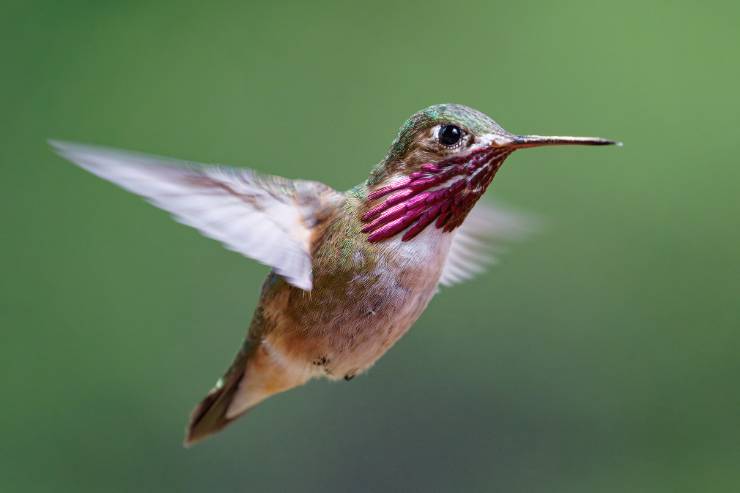
Likewise, the female and immature hummingbirds have a pinkish wash on the flanks, bronze-green back, and dark streaks on the throat. Additionally, it also has a dark tail with white tips.
This species of hummingbird is quite similar to the rufous hummingbird and the Allen’s hummingbird.
Calliope Hummingbird Size, Weight, Wingspan, Lifespan, and Breeding Period:
- Size: 2.8–3.9 inches (7–10 cm)
- Wingspan: 4.3 inches (11 cm)
- Weight: 0.071 to 0.106 ounces (2 to 3 g)
- Lifespan: seven years
- Breeding Period: April through June
The average lifespan of the calliope hummingbird is seven years. And, the oldest Calliope hummingbird was a female which records the age of at least eight years and one month old.
As per the IUCN Red List, the conservation status of this species of hummingbird is of least concern. This bird does not have any predators but can be aggressive hummingbirds in its territory.
Habitat: It is a migratory bird. The Calliope hummingbird breeding habitat is varied in the open shrub habitats and altitudes.
They can be found in open montane forests, willow, brushy areas, meadows, alder thickets, chaparral, and desert areas.
In winter, it migrates mainly from Arizona and New Mexico to southwestern Mexico. They are common native hummingbirds in the United States and Canada.
Feeding: Its main diet consists of nectar from flowers and insects. At the time of collecting nectar from flowering plants helps to assist in plant pollination.
8. Black-chinned Hummingbird (Archilochus alexandri)
The black-chinned hummingbird is small-sized and is found in a wide range of habitats. Adult hummingbirds have metallic green above and white below covered with green flanks.
Overall, they encompass the long, straight, and slender bill. It also has a glossy purple gorget that is visible in the sunlight which is bordered by a black chin.
The female and immature hummingbirds have dull metallic green in the upper parts with white tips. In contrast, the juveniles have a new set of feathers before their first year.
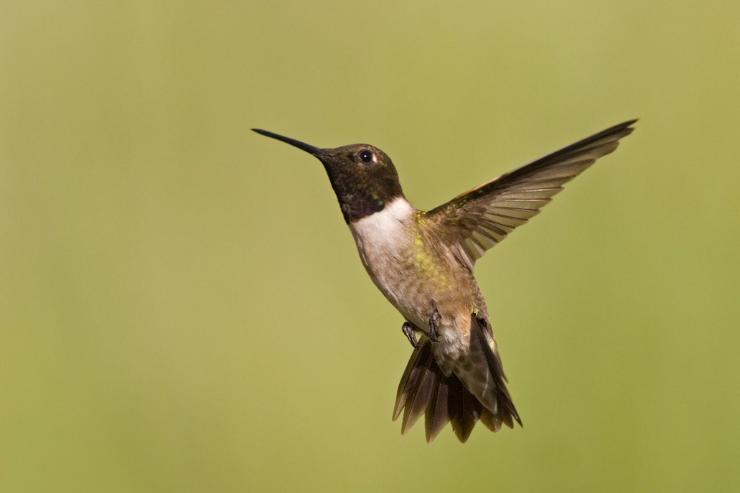
Black-chinned Hummingbird Size, Weight, Wingspan, Lifespan, and Breeding Period:
- Size: 3.25 inches (8.25 cm)
- Wingspan: 11 cm (4.3 inches)
- Weight: 2.3-4.9 g (0.1-0.2 ounces)
- Lifespan: Upto 10 years
- Breeding Period: Late March to Mid-August
Due to its broad range, population size, and growth, the IUCN Red List has listed the black-chinned hummingbird as a species of least concern.
Every decade there is a hike by 14.6% increase in the population of this bird. The black-chinned hummingbird can live up to 10 years. These birds have a high-pitched chirp.
Habitat: Black-chinned hummingbird’s breeding habitat is semiarid areas, open, usually near water sources, meadows, chaparral, mountains, orchards, and woodlands habitat.
They may be found in the western United States, Mexico, Oklahoma, Alberta, Canada, and southern British Columbia.
Feeding: These hummingbirds feed on insects and nectar from flowers with their long extendable tongue. It also assists in plant pollination.
9. Buff-bellied Hummingbird (Amazilia yucatanensis)
It is a species of hummingbird that belongs to the Trochilidae. The adult Buff-bellied hummingbird is a medium-sized bird that has a rosy reddish bill with a black tip.
The species of this male hummingbird have metallic bronze-green in the upper parts and a dark crown. The covert feather is a mix of bronze green and cinnamon rufous.
While the adult female resembles the adult male. But, the female also has a less iridescent back and throat.
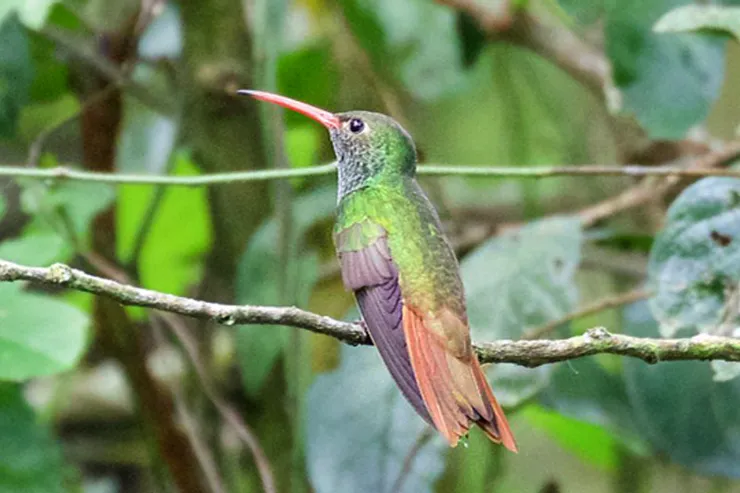
Buff-bellied Hummingbird Size, Weight, Wingspan, Lifespan, and Breeding Period:
- Size: 10 to 11 cm (3.9 to 4.3 inches)
- Weight: 2.9 to 4.7 g (0.10 to 0.17 ounces)
- Wingspan: 5.75 inches
- Lifespan: 11 years
- Breeding Period: April to August
According to the International Union for Conservation of Nature (IUCN) Red List, the buff-bellied hummingbird is assessed as the least concern.
Its exact population size is not known at the moment. But, these enchanting birds have covered a wide range of the avian world. The average lifespan of this bird is expected to be 11 years.
However, the oldest male Buff-bellied hummingbird was recorded to be at least 11 years and two months old.
Habitat: This hummingbird is a resident throughout the year from extreme southern Texas south in Mexico as far as north-central Veracruz. It can be found in semi-open areas, edges of dense forests, thorn forests, and scrubby woodlands.
Feeding: The buff-bellied hummingbird is a territorial that mainly feeds on nectar from a wide variety of flowering plants.
Along with it, this bird also consumes small arthropods that are captured by the wings or by gleaning the vegetation.
10. Broad-billed Hummingbird (Cynanthus latirostris)
It is a small hummingbird that has a bright reddish-colored long bill with a black tip. Overall, the presence of the hummingbird is dull-colored on the crown and forehead.
The adult male has a metallic dark green body with a white undertail-coverts. It also has a blue throat, a bluish-green belly, and brownish-gray flight feathers.
Similarly, the adult female has a slender body with dingy underparts and a notched tail. Its belly is pale and has a white eyestripe just behind its eye.
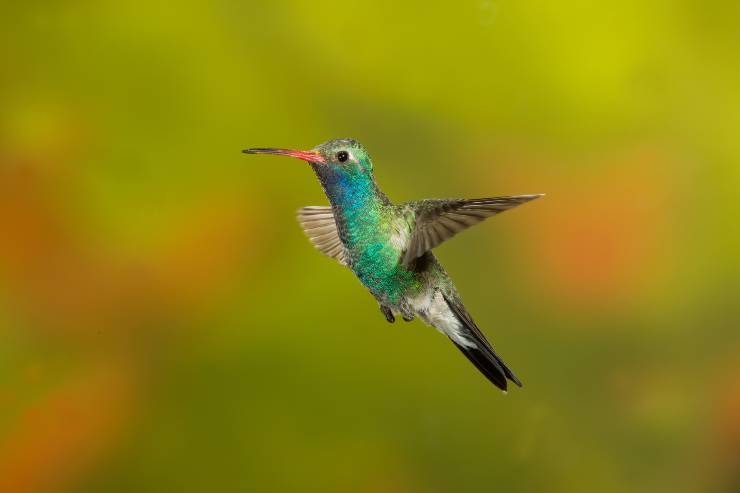
The broad-billed hummingbird is a diurnal bird that is commonly known by other names. Such as in Spanish as Colibri Pico Ancho and in French Colibri Circe.
Broad-billed Hummingbird Size, Weight, Wingspan, Lifespan, and Breeding Period:
- Size: 3.1–3.9 inches (8–10 cm)
- Weight: 3 to 4 grams
- Wingspan: 5.1 inches (13 cm)
- Lifespan: nine years
- Breeding Period: January to May (In Mexico) and April to August (In the United States)
The average lifespan of the broad-billed hummingbird is expected to be at least nine years. And, the oldest male broad-billed hummingbird was recorded to be at least nine years and one month old.
As per the IUCN Red List, the conservation status of the broad-billed hummingbird was classified as a species of least concern.
Habitat: These birds prefer to reside in the dense vegetation, streamside groves, and open oak woodlands in lower canyons. The broad-billed hummingbird is the most common bird in the state of Sonora, Mexico.
Feeding: The broad-billed hummingbird mainly feeds on the nectar and insects. This species of hummingbird is well-known for visiting sugar-water hummingbird feeders.
Its eating behavior prefers to visit red or red-and-yellow flowers the most. It catches the insects in mid-air or hovers them from a plant.
11. Broad-tailed Hummingbird (Selasphorus platycercus)
The broad-tailed hummingbird is a medium-sized hummingbird that belongs to the family of Trochilidae.
Both male and female hummingbirds have iridescent green backs, round black tails beyond their wing tips, and white eye rings.
The adult males have a big head, white breast, rose-magenta throat, and green and buffy flanks. However, the weight of females is slightly larger as compared to male hummingbirds.
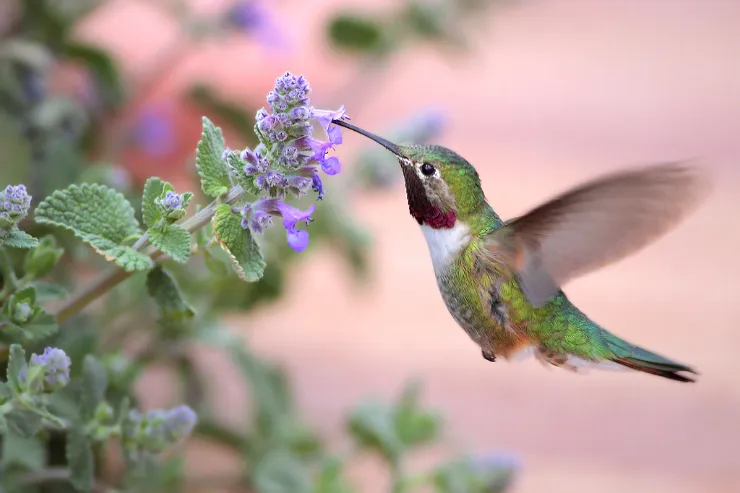
Broad-tailed Hummingbird Size, Weight, Wingspan, Lifespan, and Breeding Period:
- Size: 10 cm (4 inches)
- Weight: 3.6 g (0.13 oz)
- Wingspan: 13.3 cm (5.25 inches)
- Life span: 12 years
- Breeding Period: Early April to mid-June
Due to its wide range and moderate size population, the conservation status of the broad-tailed hummingbird is listed as a species of least concern.
As of now, it is not considered an endangered species. The life expectancy of the broad-tailed hummingbird is about 12 years.
Habitat: This captivating bird is mostly found in mountainous regions and forests. Mostly it can be spotted in open forests such as pine-oak and pinyon-juniper woods and near streams.
Their breeding habitat lies in the subalpine meadows, montane valleys, stands of spruce or aspen, and foothills.
Being a partial migratory bird, during the summer season, they are found in the western United States, Mexico, and Western Canada. Similarly, in the winter regions, they are found in Guatemala and southern Mexico.
Feeding: Primarily, the broad-tailed hummingbird’s diet mainly includes nectar from the flowering plants.
These birds consume nectar from Indian paintbrush, scarlet mint, red columbine, and many more. Beyond this, it also feeds on insects.
12. Anna’s Hummingbird (Calypte anna)
The Anna’s hummingbird was named after Anna Massena, Duchess of Rivoli. It is relatively a stocky hummingbird that has an iridescent bronze-green back and green flanks.
The adult male hummingbird has a long, slender, and straight bill. Overall, its physical appearance encompasses a reddish-pink crown and gorget, crimson-red iridescent, and slightly dark forked tail.
In like manner, the adult female hummingbird and juvenile have a dull green crown contrasting with reddish-pink feathers on the throat. It also has gray underparts and often includes a small patch in the center of the throat.
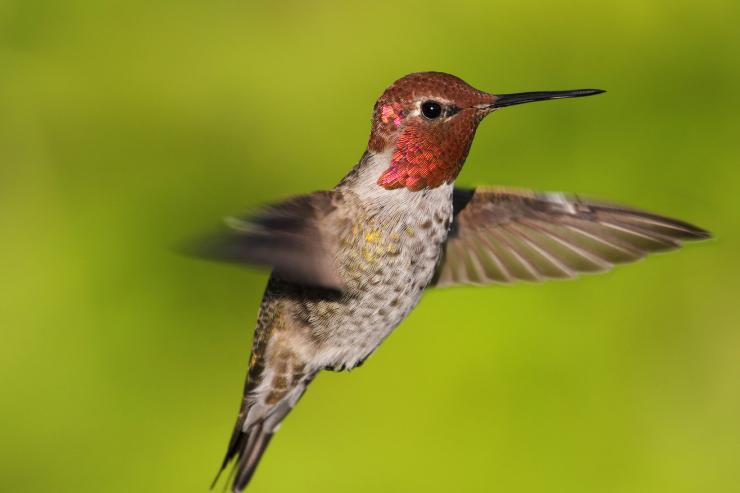
Anna’s Hummingbird Size, Weight, Wingspan, Lifespan, and Breeding Period:
- Size: 3.9 to 4.3 in (9.9 to 10.9 cm)
- Weight: 0.1 to 0.2 oz (2.8 to 5.7 g)
- Wingspan: 4.7 inches (12 cm)
- Lifespan: 8.5 years
- Breeding Period: December to May or June
As of 2021, the International Union for Conservation of Nature’s Red List of Threatened Species has assessed this bird as a species of least concern.
As of the latest data information, it has been revealed that there are around eight million hummingbirds in the western United States and Canada. The average lifespan of the anna’s hummingbird is 8.5 years.
Habitat: This majestic hummingbird can be found in a wide variety of habitats. It ranges nearby streamside groves, chaparral, open woodlands, gardens, and city parks.
Due to the increase in temperature, Anna’s hummingbird has expanded their range into the cooler summer environments at high altitudes.
They are found across the western coast of North America, southern Alaska, southern Nevada, southeastern Utah, and western Texas.
Feeding: Anna’s hummingbirds consume nectar as well as tree sap from flowering plants and insects. It also includes the sugar-water mixes from the bird feeders.
Besides this, it also forages the insects at the time of flight or catches the insects trapped in spider webs.
Conclusion:
In conclusion, the presence of hummingbirds in Georgia state has added a delightful and diverse group of avian visitors. It has not only enhanced the beauty of the state’s ecological richness and biodiversity.
But, this vibrant and colorful hummingbird symbolizes the resilience and adaptability of wildlife in the environment of avian landscapes.
Besides their aesthetically appealing presence has contributed to the health and diversity of Georgia’s flora through pollination.
From Rivoli’s Hummingbird to Anna’s Hummingbird, each of the species has played a crucial role in the avian world.






